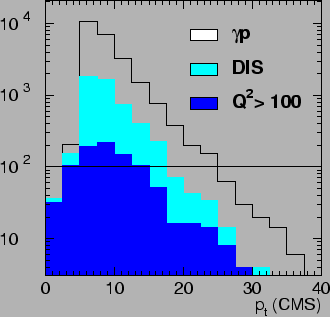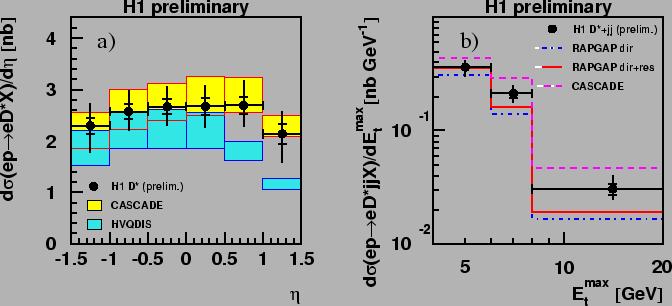With the HERA-II luminosity and new detector components
enhanced systematic precision and increased kinematic reach
will be provided by both increased statistics and
also by the use of the upgraded detector components described in
section 7.1.
The statistics can be used to reduce the statistical errors or
to increase the number of measured cross section points.
Figure 59 illustrates the kinematic reach for
reconstructed ![]() events as a function of the transverse momentum
events as a function of the transverse momentum
![]() of the charm quark.
Double and triple-differential cross section measurements,
e.g.as functions of
of the charm quark.
Double and triple-differential cross section measurements,
e.g.as functions of ![]() ,
, ![]() and
and ![]() ,
allow to probe the theoretical predictions at a deeper level
and better accuracy and characteristic effects in
specific regions of the phase space can be isolated.
,
allow to probe the theoretical predictions at a deeper level
and better accuracy and characteristic effects in
specific regions of the phase space can be isolated.
In HERA-I, differential measurements of exclusive final states
with charm (e.g. identified by the reconstruction of ![]() -meson)
were performed in the central rapidity regions (
-meson)
were performed in the central rapidity regions (
![]() )
up to transverse momenta of the
)
up to transverse momenta of the ![]() of 20 GeV (see
section 6.1.1).
While the data are generally described by pQCD calculations,
discrepancies of order 20% are seen among different theory
predictions and with the data in particular
at large transverse momenta and in the forward direction.
of 20 GeV (see
section 6.1.1).
While the data are generally described by pQCD calculations,
discrepancies of order 20% are seen among different theory
predictions and with the data in particular
at large transverse momenta and in the forward direction.
 |
This is illustrated in fig.60 in which the
H1 data are compared to predictions from different models
as a function of the pseudo-rapidity of ![]() mesons and of the
transverse energy
mesons and of the
transverse energy ![]() of jets in charm events.
In general, the cross section predictions from CASCADE are
higher towards large values of
of jets in charm events.
In general, the cross section predictions from CASCADE are
higher towards large values of ![]() and
and ![]() of the charm quark than those from calculations in the collinear
factorization scheme using the DGLAP evolution equations.
The HERA-II data are expected to provide sufficient precision
to unambiguously discriminate between the different models.
The upgraded forward detectors of H1 and ZEUS and more luminosity
will make the forward region, i.e.regions of pseudo-rapidity
larger than 1.5, more accessible than it has been so far.
of the charm quark than those from calculations in the collinear
factorization scheme using the DGLAP evolution equations.
The HERA-II data are expected to provide sufficient precision
to unambiguously discriminate between the different models.
The upgraded forward detectors of H1 and ZEUS and more luminosity
will make the forward region, i.e.regions of pseudo-rapidity
larger than 1.5, more accessible than it has been so far.
 |
Measurements of exclusive final states with jets give access to a number of
aspects of heavy quark production and fragmentation as the jets contain
information about the kinematics and type of the hard partonic interaction.
In photoproduction and at small values of ![]() ,
,
![]() the measurement of jet correlations
gives access to the hadronic structure of resolved photons.
As explained in section 2.3
the particular role of heavy quarks in resolved photon processes
is yet to be clarified. The measurement of the shape of the
the measurement of jet correlations
gives access to the hadronic structure of resolved photons.
As explained in section 2.3
the particular role of heavy quarks in resolved photon processes
is yet to be clarified. The measurement of the shape of the
![]() distribution and of dijet angular distributions
of charm jets in different regions of
distribution and of dijet angular distributions
of charm jets in different regions of
![]() have given first insights into the relative fractions of
the processes of gluon-gluon fusion and charm-excitation.
High statistics measurements will allow to obtain details
at better precision and to determine the dependence on the
external scales
have given first insights into the relative fractions of
the processes of gluon-gluon fusion and charm-excitation.
High statistics measurements will allow to obtain details
at better precision and to determine the dependence on the
external scales ![]() and
and ![]() , where
, where ![]() is the transverse
momentum of the final state jets.
is the transverse
momentum of the final state jets.
The measurement of dijet correlations gives access to the
distribution of gluons from the proton in the initial state.
In the ![]() factorization scheme, the
factorization scheme, the ![]() of
the gluon can be determined. Predictions in the
of
the gluon can be determined. Predictions in the ![]() factorization
scheme (CCFM-evolution equation) differ from those using the
DGLAP evolution equation in particular in the forward region, i.e.
at large values of pseudo-rapidity. Measurements in the forward
direction will provide for valuable tests of the different approaches.
factorization
scheme (CCFM-evolution equation) differ from those using the
DGLAP evolution equation in particular in the forward region, i.e.
at large values of pseudo-rapidity. Measurements in the forward
direction will provide for valuable tests of the different approaches.
The HERA-I data have already provided precise input to
the issue of fragmentation. Comparisons of the HERA-data
with results from LEP have shown that
the assumption of universality is justified. This is
all the more interesting as the typical jet energies at HERA
are around 10 GeV, and thus significantly lower than those
at LEP.
One useful question to be addressed with high statistics HERA-II
data is to confirm the finding that the fragmentation is
independent of the energy by measuring the fragmentation for
different processes and at different energies within
the same experiment.
Furthermore, a fit of the fragmentation distributions could help to
discriminate between different fragmentation models, e.g.
Lund, [108], Peterson [109],
Kartvelishvili [113].
These studies should be performed for both
fragmentation fractions and
fragmentation functions of charm.
For beauty, the production cross sections and branching ratios
are too small to allow a full reconstruction of a sufficiently
large sample of ![]() -hadrons with the statistics expected at
HERA.
-hadrons with the statistics expected at
HERA.
The analysis of charm and beauty events in which both quark and anti-quark
are explicitly identified is particularly useful for the study
of heavy quark production at small transverse momenta.
Due to the double-tag the background from ![]() events is strongly
suppressed. This allows to perform measurements at small
transverse momenta and small invariant masses
events is strongly
suppressed. This allows to perform measurements at small
transverse momenta and small invariant masses
![]() where
present results indicate an excess of the data over the expectations.
These data samples allow to make measurements to very small transverse
momenta of the quark and anti-quarks, such that the total
cross section can be measured with few or no model assumptions.
where
present results indicate an excess of the data over the expectations.
These data samples allow to make measurements to very small transverse
momenta of the quark and anti-quarks, such that the total
cross section can be measured with few or no model assumptions.